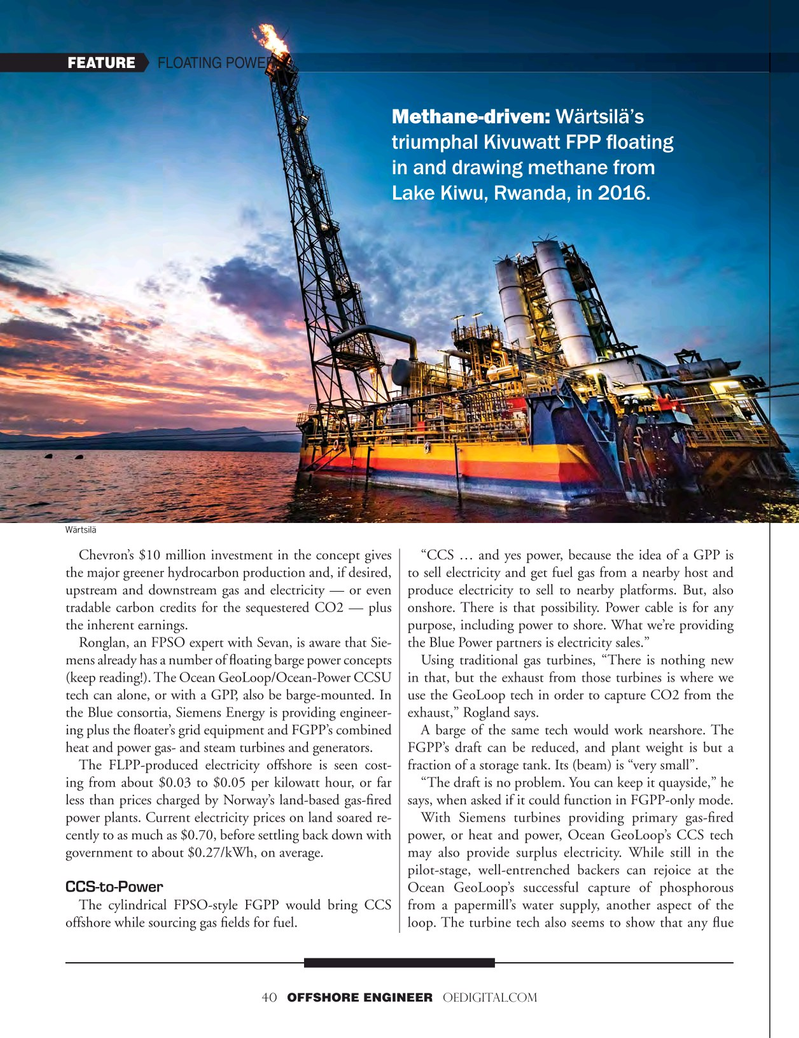
Page 40: of Offshore Engineer Magazine (Nov/Dec 2022)
Read this page in Pdf, Flash or Html5 edition of Nov/Dec 2022 Offshore Engineer Magazine
FEATURE FLO ATING POWER
Methane-driven: Wärtsilä’s in and drawing methane from
Lake Kiwu, Rwanda, in 2016.
Wärtsilä
Chevron’s $10 million investment in the concept gives “CCS … and yes power, because the idea of a GPP is the major greener hydrocarbon production and, if desired, to sell electricity and get fuel gas from a nearby host and upstream and downstream gas and electricity — or even produce electricity to sell to nearby platforms. But, also tradable carbon credits for the sequestered CO2 — plus onshore. There is that possibility. Power cable is for any the inherent earnings. purpose, including power to shore. What we’re providing
Ronglan, an FPSO expert with Sevan, is aware that Sie- the Blue Power partners is electricity sales.” mens already has a number of ?oating barge power concepts Using traditional gas turbines, “There is nothing new (keep reading!). The Ocean GeoLoop/Ocean-Power CCSU in that, but the exhaust from those turbines is where we tech can alone, or with a GPP, also be barge-mounted. In use the GeoLoop tech in order to capture CO2 from the the Blue consortia, Siemens Energy is providing engineer- exhaust,” Rogland says.
ing plus the ?oater’s grid equipment and FGPP’s combined A barge of the same tech would work nearshore. The heat and power gas- and steam turbines and generators. FGPP’s draft can be reduced, and plant weight is but a
The FLPP-produced electricity offshore is seen cost- fraction of a storage tank. Its (beam) is “very small”. ing from about $0.03 to $0.05 per kilowatt hour, or far “The draft is no problem. You can keep it quayside,” he less than prices charged by Norway’s land-based gas-?red says, when asked if it could function in FGPP-only mode. power plants. Current electricity prices on land soared re- With Siemens turbines providing primary gas-?red cently to as much as $0.70, before settling back down with power, or heat and power, Ocean GeoLoop’s CCS tech government to about $0.27/kWh, on average. may also provide surplus electricity. While still in the pilot-stage, well-entrenched backers can rejoice at the
CCS-to-Power Ocean GeoLoop’s successful capture of phosphorous
The cylindrical FPSO-style FGPP would bring CCS from a papermill’s water supply, another aspect of the offshore while sourcing gas ?elds for fuel. loop. The turbine tech also seems to show that any ?ue 40 OFFSHORE ENGINEER OEDIGITAL.COM

 39
39

 41
41